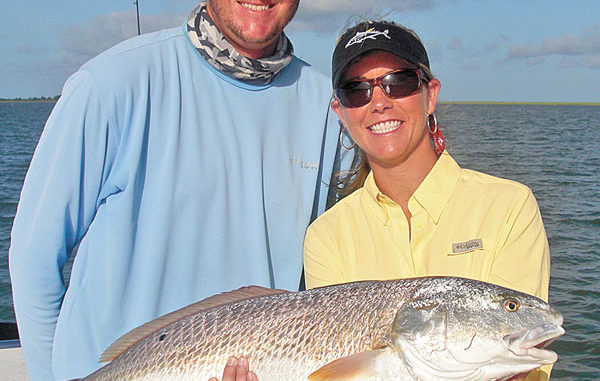
Putting in at historic McClellanville allows fishermen to aim right for the heart of the Cape Romain National Wildlife Refuge, which stretches 22 miles along the coast just north of the Isle Of Palms and encompasses more than 66,000-acres of marshes, maritime forests and waterways.
With seasonal visitors like tarpon and loggerhead turtles, this sanctuary is important to many species — but to the year-round, resident redfish, it simply is the perfect home.
Not all of the marsh is protected, but anglers will see the familiar “blue goose” signs when you’re next to the refuge. Redfish, of course, don’t read the signs, so they take full advantage of every spartina flat, mud flat, sand bottom, shell point and oyster bed that they can. World-class birding can also occur while targeting redfish, like sighting a swallow-tailed kite or an endangered oystercatcher.
Capt. Jamie Hough of Charleston likes to fish out of McClellanville on occasion to get away from the Charleston Harbor boat traffic that can sometimes occur. Of course, it doesn’t hurt that there is an army of redfish waiting to march and munch on the artificial lures presented in the clearer waters of October.
What artificial lures produce strikes in October? Hough has a favorite.
“October is my favorite month to fish, and my favorite grub in October is the Saltwater Assassin ‘Chicken on a Chain’ with a quarter-ounce jighead,” he said.
Anglers should also have a vast array of soft plastics like the Berkley Gulp! 3-inch shrimp, spoons like the Nemire gold spoon or Red-Ripper Spoon Buzzer, which has a spinner on the front end. Don’t forget a MirrOlure MirrOdine in menhaden pattern, something Hough calls his “flounder pounder” during summer, and the standard DOA Deadly Combo, an artificial shrimp fished under a cork. Hough prefers a weighted float to give better distance when casting.
Whether fishing near the breakers or pushing up onto the flats, Hough recommends keeping a sharp eye for redfish pushes, muddy swirls, and, of course, tails in the air.
Fishing with Hough while he pre-fished for a tournament, I learned a great tip for landing redfish in the marsh, in this case, the Cowpens marsh in Mud Bay.
When a bull redfish ate my Berkely Gulp! offering on a 2/0 Gamakatsu hook, the reel sang like a siren going off. The redfish took the bait while cruising along the marsh edge in three to four feet of water, but then headed straight into the fully-flooded spartina grass
“Go ahead and loosen up your drag if you want to get that fish,” Hough said. “That sound advice did not sink in quickly enough, because I tightened the drag a bit wanting to turn the fish, and Pop! — the line parted.
Re-rigged in a flash and casting again to the same spot, another bull red took the bait and headed right into the flooded grass. This time, the drag was dialed down until there was almost no resistance. Guess what? That fish stopped swimming into the marsh, sat and lolly-gagged briefly, then swam out, allowing me to tighten up the drag and land the 32-inch whopper for a digital memory.
Why would a redfish give up the advantage it gained by being up in the grass?
“He has to get water flowing over his gills sooner or later, and he’s not gonna let himself get caught in the marsh when the tide turns to go out. All redfish abandon the spartina grass with the first chug of the outgoing tide.”
Moving to the ICW near the landing in Jeremy Creek, Hough likes to visit an area where he and tournament partner Ronnie Pitts have found of a vast school of redfish said to stretch 100 yards. Other boats are often fishing in the same stretch, which is close to McClellanville.
When Amy Little got hooked up with a fine, 28½-inch redfish she said, “It’s not fighting like those other fish.” But with the tide lower, the spot-tailed bass had no flooded grass option, and it wore down more quickly because it was swimming a lot more.
Whether casting along the grass with artificials, push-poling the flats or fishing the breakers in front of the Bulls Island “boneyard,” redfish will be ready. They are there year-round, but October has them feeling hardier and taking the bait with authority. Catch-and-release is a good way to make sure that the “redfish refuge” stays just that. Consider that 28,000 acres of the refuge is the only Class I Wilderness Area in South Carolina and is home to some of the cleanest air and water in the entire National Wildlife Refuge system.



Be the first to comment